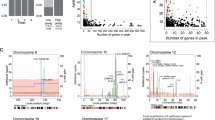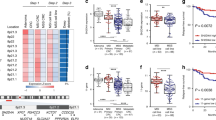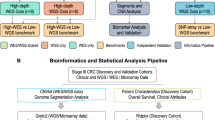Abstract
Microsatellite-stable, near-diploid (MSI−CIN−) colorectal carcinomas have been reported, but it is not clear as to whether these tumours form a discrete group or represent one end of the distribution of MSI−CIN+ cancers. In order to address this question, we screened 23 MSI−CIN− colorectal cancers for gains and losses using array-based comparative genomic hybridization (aCGH) based on large-insert clones at about 1 Mb density. We compared our findings with those from a small set of MSI+CIN+ cancers, and with our reported data from MSI−CIN+ and MSI+CIN− cancers. We found no evidence of any form of genomic instability in MSI−CIN− cancers. At the level of the chromosome arm, the MSI−CIN− cancers had significantly fewer gains and losses than MSI−CIN+ tumours, but more than the MSI+CIN− and MSI+CIN+ lesions. The chromosomal-scale changes found in MSI−CIN− cancers generally involved the same sites as those in MSI−CIN+ tumours, and in both cancer groups, the best predictor of a specific change was the total number of such changes in that tumour. A few chromosomal-scale changes did, however, differ between the MSI−CIN− and MSI−CIN+ pathways. MSI−CIN− cancers showed: low frequencies of gain of 9p and 19p; infrequent loss of 5q and a high frequency of 20p gain. Overall, our data suggested that the MSI−CIN− group is heterogeneous, one type of MSI−CIN− cancer having few (⩽6) chromosomal-scale changes and the other with more (⩾10) changes resembling MSI−CIN+ cancers. At the level of individual clones, frequent and/or discrete gains or losses were generally located within regions of chromosomal-scale changes in both MSI−CIN− and MSI−CIN+ cancers, and fewer losses and gains were present in MSI−CIN− than MSI−CIN+ tumours. No changes by clone, which were specific to the MSI−CIN− cancers, were found. In addition to indicating differences among the cancer groups, our results also detected over 50 sites (amplifications, potential homozygous deletion and gains or losses which extended over only a few megabases) which might harbour uncharacterized oncogenes or tumour suppressor loci. In conclusion, our data support the suggestion that some MSI−CIN− carcinomas form a qualitatively different group from the other cancer types, and also suggest that the MSI−CIN− group is itself heterogeneous.
This is a preview of subscription content, access via your institution
Access options
Subscribe to this journal
Receive 50 print issues and online access
$259.00 per year
only $5.18 per issue
Buy this article
- Purchase on Springer Link
- Instant access to full article PDF
Prices may be subject to local taxes which are calculated during checkout




Similar content being viewed by others
References
Curtis LJ, Georgiades IB, White S, Bird CC, Harrison DJ and Wyllie AH . (2000). J. Pathol., 192, 440–445.
Douglas EJ, Fiegler H, Rowan AJ, Halford SE, Bicknell DC, Bodmer WF, Tomlinson IPM and Carter NP . (2004). Cancer Res., 64, 4817–4825.
Fiegler H, Carr P, Douglas EJ, Burford DC, Hunt S, Scott CE, Smith J, Vetrie D, Gorman P, Tomlinson IP and Carter NP . (2003). Genes Chromosomes Cancer, 36, 361–374.
Georgiades IB, Curtis LJ, Morris RM, Bird CC and Wyllie AH . (1999). Oncogene, 18, 7933–7940.
Giaretti W, Venesio T, Sciutto A, Prevosto C, Geido E and Risio M . (2003). Genes Chromosomes Cancer, 37, 207–213.
Gill N, Malik A, Potti A, Talukdar R, Saberi A and Mehdi SA . (2002). Gastroenterology, 122, 248–249.
Guanti G, Resta N, Simone C, Cariola F, Demma I, Fiorente P and Gentile M . (2000). Hum. Mol. Genet., 9, 283–287.
Hawkins NJ, Tomlinson I, Meagher A and Ward RL . (2001). Br. J. Cancer, 84, 232–236.
Iino H, Jass JR, Simms LA, Young J, Leggett B, Ajioka Y and Watanabe H . (1999). J. Clin. Pathol., 52, 5–9.
Jain AN, Tokuyasu TA, Snijders AM, Segraves R, Albertson DG and Pinkel D . (2002). Genome Res., 12, 325–332.
Jass JR, Whitehall VL, Young J and Leggett BA . (2002). Gastroenterology, 123, 862–876.
Leach FS, Elledge SJ, Sherr CJ, Willson JK, Markowitz S, Kinzler KW and Vogelstein B . (1993). Cancer Res., 53, 1986–1989.
Lipton L, Halford SE, Johnson V, Novelli MR, Jones A, Cummings C, Barclay E, Sieber O, Sadat A, Bisgaard ML, Hodgson SV, Aaltonen LA, Thomas HJ and Tomlinson IP . (2003). Cancer Res., 63, 7595–7599.
Markowitz S, Wang J, Myeroff L, Parsons R, Sun L, Lutterbaugh J, Fan RS, Zborowska E, Kinzler KW and Vogelstein B et al. (1995). Science, 268, 1336–1338.
Nakao K, Mehta KR, Fridlyand J, Moore DH, Jain AN, Lafuente A, Wiencke JW, Terdiman JP and Waldman FM . (2004). Carcinogenesis, 25, 1345–1357.
Nassif NT, Lobo GP, Wu X, Henderson CJ, Morrison CD, Eng C, Jalaludin B and Segelov E . (2004). Oncogene, 23, 617–628.
Pedowitz SD, Matulewicz T, Croft C, Rudolph H, Strada D, Keifer JA and Topilow AA . (2003). Gastroenterology, 125, 1915–1916; author reply 1916.
Pinkel D, Segraves R, Sudar D, Clark S, Poole I, Kowbel D, Collins C, Kuo WL, Chen C, Zhai Y, Dairkee SH, Ljung BM, Gray JW and Albertson DG . (1998). Nat. Genet., 20, 207–211.
Toyota M, Ahuja N, Ohe- Toyota M, Herman JG, Baylin SB and Issa JP . (1999). Proc. Natl. Acad. Sci. USA, 96, 8681–8686.
Yamashita K, Dai T, Dai Y, Yamamoto F and Perucho M . (2003). Cancer Cell, 4, 121–131.
Acknowledgements
We thank the Sanger Institute Microarray Facility for printing of arrays and Cancer Research UK for support. Colleagues at St Mark's Hospital Kindly assisted with sample collection and provision of clinicopathological data.
Author information
Authors and Affiliations
Corresponding author
Rights and permissions
About this article
Cite this article
Jones, A., Douglas, E., Halford, S. et al. Array-CGH analysis of microsatellite-stable, near-diploid bowel cancers and comparison with other types of colorectal carcinoma. Oncogene 24, 118–129 (2005). https://doi.org/10.1038/sj.onc.1208194
Received:
Revised:
Accepted:
Published:
Issue Date:
DOI: https://doi.org/10.1038/sj.onc.1208194
Keywords
This article is cited by
-
SNP array genomic analysis of matched pairs of brain and liver metastases in primary colorectal cancer
Journal of Cancer Research and Clinical Oncology (2023)
-
DNA alterations in Cd133+ and Cd133- tumour cells enriched from intra-operative human colon tumour biopsies
BMC Cancer (2017)
-
DNA copy number alterations, gene expression changes and disease-free survival in patients with colorectal cancer: a 10 year follow-up
Cellular Oncology (2016)
-
Meta-analysis of three genome-wide association studies identifies susceptibility loci for colorectal cancer at 1q41, 3q26.2, 12q13.13 and 20q13.33
Nature Genetics (2010)
-
DNA profiling by array comparative genomic hybridization (CGH) of peripheral blood mononuclear cells (PBMC) and tumor tissue cell in non-small cell lung cancer (NSCLC)
Molecular Biology Reports (2009)



